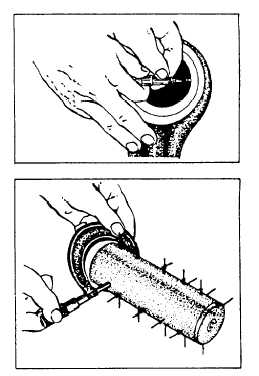be burned in the cylinder. This results in the
accumulation of excessive carbon deposits.
Crown and Land Dragging
Pistons and liners may become sufficiently worn to
permit the piston to cock over in the cylinder. This
allows the crown and ring lands to drag on the cylinder
wall. The results of dragging can be determined by
visually inspecting the parts of the piston in question.
Piston Wear
Although piston wear is normal in all engines, the
amount and rate of piston wear depend on several
controllable factors. (The causes of excessive piston
wear, and crown and land dragging, are also the causes
of other piston troubles.)
One of the controllable factors is LUBRICATION.
An adequate supply of oil is essential to provide the film
necessary to cushion the piston and other parts within
the cylinder and prevent metal-to-metal contact.
Inadequate lubrication will not only cause piston wear
and crown and land dragging, but also may cause piston
seizure, and piston pin busing wear.
Lack of lubrication is caused either by a lack of lube
oil pressure or by restricted oil passages. The
pressure-recording instruments usually give warning of
low oil pressure before any great harm results. However,
clogged passages offer no such warnings, and their
discovery depends on the care that is exercised in
inspecting and cleaning the piston and connecting rod
assembly.
Another controllable factor that may be directly or
indirectly responsible for many piston troubles is
IMPROPER COOLING WATER TEMPERATURE.
If an engine is not operated within the specified
temperature limits, lubrication troubles will develop.
High cylinder surface temperatures will reduce the
viscosity of the oil. As the cylinder lubricant thins, it will
run off the surfaces. The resulting lack of lubrication
leads to excessive piston and liner wear. However, if
temperatures are below those specified for operation,
viscosity will be increased, and the oil will not readily
reach the parts requiring lubrication.
Oil plays an important role in the cooling of the
piston crown. If the oil flow to the underside of the
crown is restricted, deposits caused by oxidation of the
oil will accumulate, lowering the rate of heat transfer.
Therefore, the underside of the piston crown should be
thoroughly cleaned whenever pistons are removed
While insufficient and uneven cooling may cause
ring land failure, excessive temperatures may cause
piston seizure; an increase in the rates of oxidation of
the oil, resulting in clogged oil passages; or damage to
piston pin bushings.
Seizure or excessive wear of pistons may be caused
by IMPROPER PIT. New pistons or liners must be
installed with the piston-to-cylinder clearances
specified in the manufacturer’s instruction manual.
PISTON PINS AND SLEEVE BEARINGS OR
BUSHINGS
Every time you remove a piston assembly from an
engine, inspect it for wear. Measure the piston pins and
sleeve bearings or bushings with a micrometer, as shown
in figure 3-25, to determine whether wear is excessive.
Do NOT measure areas that do not make contact. Such
areas include those between the connecting rod and
piston bosses and areas under the oil holes and grooves.
You can press bushings out of the rod with a mandrel
and an arbor press or with special tools, as shown in
figure 3-26. You can also remove bushings by firt
shrinking them with dry ice. Dry ice will also make it
easier to insert the new bushing.
Figure 3-25.—Measuring a piston pin and piston bushing for
wear.
3-17

